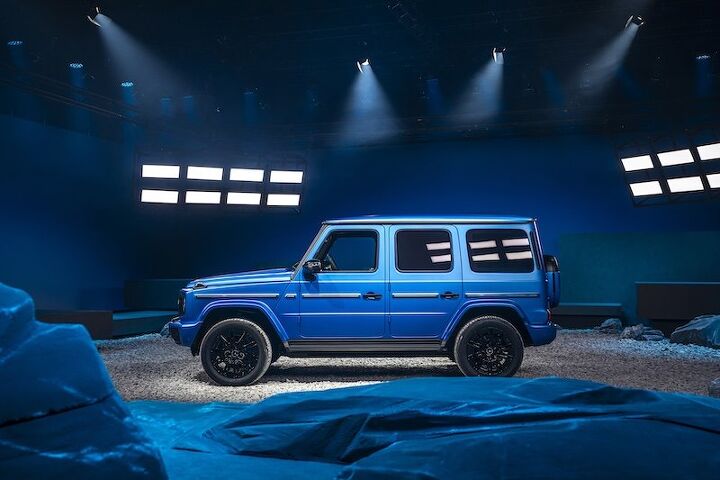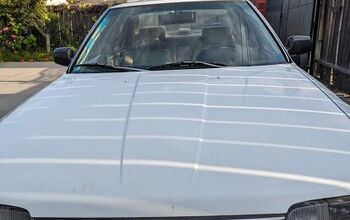Geländewagen, Electrified: Mercedes-Benz G 580 with EQ Technology

Electrification has crept like a static-filled blanket over the Mercedes shop floor, consuming just about every major model in a wide variety of segments in which the German automaker is present – although it must be said that, for now, there are plenty of gassers from which to select.
Most rightly predicted an electrified G would retain the popular boxy looks for which it is known. What we can’t fathom, however, is its official name: Why not simply EQG?
Surely there is a marketing group armed with focus group data deep in the bowels of Stuttgart who can answer that question with an appropriate level of PR bluster. What isn’t up for debate is that Mercedes seems bent on not sullying their most profitable of consonants. The electric G features a ladder frame design, selectable low range off-road gear reduction, an independent front suspension, and solid rear axle. Those electric motors are good for 579 horsepower and 859 lb-ft of torque. A sprint from 0–60 mph is said to take 4.7 seconds.
A 116-kWh lithium-ion battery provides the juice but Merc isn’t yet spilling any tea about expected driving range on a full charge. The EQS 580 SUV, which the wind likely thinks is more aerodynamic, has a battery pack of roughly the same capacity and a suggested range of about 330 miles. Will the G crest three hundred? Or will its signature box-on-wheels shape scupper that goal? We shall see when Merc is good and ready – or when the feds officially rate it. In terms of charging, it can hoover up electricity at 200 kW from a sufficiently robust DC fast charger.
The electric G (we refuse to type out its ridiculously long full name) stands 182.0 inches long on a 113.8-inch wheelbase and is 78.2 inches tall. There is 19.6 cubic feet of cargo space behind the rear seat. This is in contrast to a 2024 gasoline-powered G which is 189.7 inches long on a 113.8-inch wheelbase and stands 77.5 inches tall. In that rig, there is 38.1 cubes of room with all seats in place. Maximum cargo capacity is about the same, suggesting there may be more space for people than gear in the electric G thanks to battery layout.
Its interior is broadly familiar, with upright surfaces and a pair of 12.4-inch screens for gauge and infotainment duty. New camera setting can permit a so-called transparent hood, a feature designed for off-road but one which will surely be used as a party trick outside the Nobu restaurant. And, yes, given the proper surface adhesion (or lack thereof), it should be able to spin in place as it did during that preview on the strip in Vegas. Specifically, Merc says the feature can be used “to rotate the vehicle on the spot on loose or unpaved surfaces.” Watch for the TikTok fail videos in short order.
Expect to find these things prowling around tony neighborhoods in the second half of this year.
[Images: Mercedes-Benz]
Become a TTAC insider. Get the latest news, features, TTAC takes, and everything else that gets to the truth about cars first by subscribing to our newsletter.

Matthew buys, sells, fixes, & races cars. As a human index of auto & auction knowledge, he is fond of making money and offering loud opinions.
More by Matthew Guy
Latest Car Reviews
Read moreLatest Product Reviews
Read moreRecent Comments
- Kmars2009 I rented one last fall while visiting Ohio. Not a bad car...but not a great car either. I think it needs a new version. But CUVs are King... unfortunately!
- Ajla Remember when Cadillac introduced an entirely new V8 and proceeded to install it in only 800 cars before cancelling everything?
- Bouzouki Cadillac (aka GM!!) made so many mistakes over the past 40 years, right up to today, one could make a MBA course of it. Others have alluded to them, there is not enough room for me to recite them in a flowing, cohesive manner.Cadillac today is literally a tarted-up Chevrolet. They are nice cars, and the "aura" of the Cadillac name still works on several (mostly female) consumers who are not car enthusiasts.The CT4 and CT5 offer superlative ride and handling, and even performance--but, it is wrapped in sheet metal that (at least I think) looks awful, with (still) sub-par interiors. They are niche cars. They are the last gasp of the Alpha platform--which I have been told by people close to it, was meant to be a Pontiac "BMW 3-series". The bankruptcy killed Pontiac, but the Alpha had been mostly engineered, so it was "Cadillac-ized" with the new "edgy" CTS styling.Most Cadillacs sold are crossovers. The most profitable "Cadillac" is the Escalade (note that GM never jack up the name on THAT!).The question posed here is rather irrelevant. NO ONE has "a blank check", because GM (any company or corporation) does not have bottomless resources.Better styling, and superlative "performance" (by that, I mean being among the best in noise, harshness, handling, performance, reliablity, quality) would cost a lot of money.Post-bankruptcy GM actually tried. No one here mentioned GM's effort to do just that: the "Omega" platform, aka CT6.The (horribly misnamed) CT6 was actually a credible Mercedes/Lexus competitor. I'm sure it cost GM a fortune to develop (the platform was unique, not shared with any other car. The top-of-the-line ORIGINAL Blackwing V8 was also unique, expensive, and ultimately...very few were sold. All of this is a LOT of money).I used to know the sales numbers, and my sense was the CT6 sold about HALF the units GM projected. More importantly, it sold about half to two thirds the volume of the S-Class (which cost a lot more in 201x)Many of your fixed cost are predicated on volume. One way to improve your business case (if the right people want to get the Green Light) is to inflate your projected volumes. This lowers the unit cost for seats, mufflers, control arms, etc, and makes the vehicle more profitable--on paper.Suppliers tool up to make the number of parts the carmaker projects. However, if the volume is less than expected, the automaker has to make up the difference.So, unfortunately, not only was the CT6 an expensive car to build, but Cadillac's weak "brand equity" limited how much GM could charge (and these were still pricey cars in 2016-18, a "base" car was ).Other than the name, the "Omega" could have marked the starting point for Cadillac to once again be the standard of the world. Other than the awful name (Fleetwood, Elegante, Paramount, even ParAMOUR would be better), and offering the basest car with a FOUR cylinder turbo on the base car (incredibly moronic!), it was very good car and a CREDIBLE Mercedes S-Class/Lexus LS400 alternative. While I cannot know if the novel aluminum body was worth the cost (very expensive and complex to build), the bragging rights were legit--a LARGE car that was lighter, but had good body rigidity. No surprise, the interior was not the best, but the gap with the big boys was as close as GM has done in the luxury sphere.Mary Barra decided that profits today and tomorrow were more important than gambling on profits in 2025 and later. Having sunk a TON of money, and even done a mid-cycle enhancement, complete with the new Blackwing engine (which copied BMW with the twin turbos nestled in the "V"!), in fall 2018 GM announced it was discontinuing the car, and closing the assembly plant it was built in. (And so you know, building different platforms on the same line is very challenging and considerably less efficient in terms of capital and labor costs than the same platform, or better yet, the same model).So now, GM is anticipating that, as the car market "goes electric" (if you can call it that--more like the Federal Government and EU and even China PUSHING electric cars), they can make electric Cadillacs that are "prestige". The Cadillac Celestique is the opening salvo--$340,000. We will see how it works out.
- Lynn Joiner Lynn JoinerJust put 2,000 miles on a Chevy Malibu rental from Budget, touring around AZ, UT, CO for a month. Ran fine, no problems at all, little 1.7L 4-cylinder just sipped fuel, and the trunk held our large suitcases easily. Yeah, I hated looking up at all the huge FWD trucks blowing by, but the Malibu easily kept up on the 80 mph Interstate in Utah. I expect a new one would be about a third the cost of the big guys. It won't tow your horse trailer, but it'll get you to the store. Why kill it?
- Lynn Joiner Just put 2,000 miles on a Chevy Malibu rental from Budget, touring around AZ, UT, CO for a month. Ran fine, no problems at all, little 1.7L 4-cylinder just sipped fuel, and the trunk held our large suitcases easily. Yeah, I hated looking up at all the huge FWD trucks blowing by, but the Malibu easily kept up on the 80 mph Interstate in Utah. I expect a new one would be about a third the cost of the big guys. It won't tow your horse trailer, but it'll get you to the store. Why kill it?










































Comments
Join the conversation
Yeah black eyeliner was cool, when Davey Havok was still wearing it.
They won't be sold just in Beverly Hills - there's a Nieman-Marcus in nearly every big city. When they're finally junked, the transfer case will be first to be salvaged, since it'll be unused.